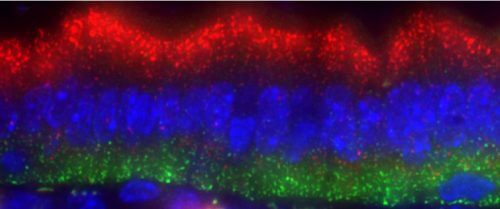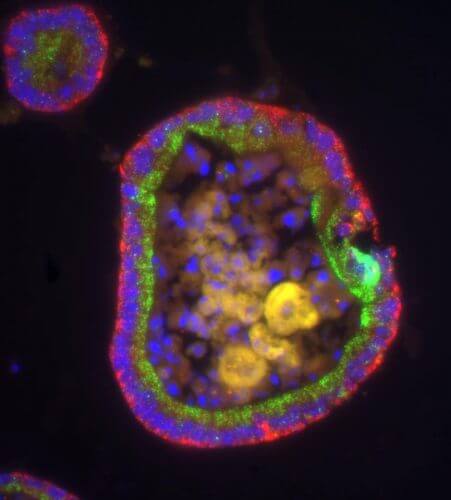Weizmann Institute scientists have discovered a mechanism that allows the intestinal cells to digest food efficiently and quickly

Every time we swallow food, the cells in the intestinal lining, which had been dormant until then, suddenly and dramatically increase their activity. In a new study by Weizmann Institute researchers, which Recently published in the scientific journal Science, it was found that these cells face the challenge with the help of a strategy known from the world of economics. Similar to managers or engineers, these cells can, in theory, operate in two ways: invest all resources in the immediate production of proteins needed for digestion, or alternatively, invest all resources first in the machines and tools necessary for increased production of proteins. In economics and engineering, it is known that under certain circumstances, the second approach is more effective. dr His Itzkowitz And his group, in the department of molecular biology of the cell, discovered that this is exactly the approach prevalent in the intestinal mucosa.
The intestinal lining is made of a single layer of elongated cells, which come in contact with the food on one side and with the blood circulation on the other side - thus transferring the nutrients from side to side, from the abdominal cavity to the blood circulation. The scientists found that molecules called messenger RNA, which carry the genetic code, are unequally distributed between the two sides of the cell: about 30% of the genes involved in intestinal activity produce messenger RNA located on one side or the other , but not in both. In addition, the two sides of the cell differ in terms of the number of ribosomes - the molecular machines for producing proteins: on the side of the cell facing the abdominal cavity, a double amount of ribosomes was discovered compared to the part of the cell facing the bloodstream. As a result, messenger RNA-based protein production is much more efficient on the food-facing side.
Later, the scientists discovered that when food enters the intestines, the cells in the lining react immediately by creating new "equipment" - i.e. ribosomes - especially in the part of the cell that faces the food. In order to ensure an adequate concentration of these machines, the cell sends to this area large amounts of messenger RNA which carries the genetic code for the creation of the ribosomes. This way, this side of the cell becomes a kind of active production factory, massively producing the proteins necessary for digestion.
Dr. Itzkovits explains: "The cells in the intestinal lining sit inactive for most of the day and night, but as soon as food appears, they have to start working immediately. If these cells produced new messenger RNA molecules in order to produce many proteins, they would need about half an hour to do so. But they do it in a way that greatly shortens the process: they increase the production of certain proteins within a few minutes, by transporting relevant messenger RNA molecules to the region of the cell rich in ribosomes. That way they can deal with the arrival of the food quickly and efficiently."
The cells in the intestinal lining sit idle most of the day and night, but as soon as food appears, they need to start working immediately. If these cells produced new messenger RNA molecules in order to produce many proteins, they would need about half an hour to do so. But they do it in a way that greatly shortens the process"

The scientists began the study after seeing that certain messenger RNA molecules accumulate in the intestinal lining in the outward-facing part of the cell, while other messenger RNA molecules accumulate in the inward-facing part of the cell. In order to find out the reason for this, they used a method that makes it possible to determine the location of individual messenger RNA molecules, in combination with a laser capture microdissection method, which makes it possible to cut out parts of the cell, and classify the proteins and the RNA molecules N.E. Courier found in each part. Using these methods, the scientists studied the distribution of messenger RNA molecules in cells taken from the intestinal mucosa of mice, in two situations - after fasting, and immediately after eating. The scientists were also looking for "molecular equipment" that transports messenger RNA from one side of the cell to the other. To this end, they grew in a plate, from the stem cells of the intestines, tiny round structures that mimic the intestinal lining, and thus located proteins that serve as a "mini-motor" to transport messenger RNA along the cell skeleton, to the desired location.
These studies indicate a new direction for the study of the control of protein production in different tissues - kidneys, liver and other internal organs. These findings may also have implications for medical research: the mucosa protects the intestines, and plays an important role in absorbing nutrients from food. Disruptions in this thin layer can cause many diseases. It is possible that following the new research it will be possible to determine whether intestinal diseases, such as Crohn's or bowel cancer, are caused in part by disruptions in the location of messenger RNA.
Dr. Anders Mor, Matan Golan, Efi Massa, Dr. Doron Lemze, Tomer Weisman, Rom Shanhav and Shaked Beydetz from the Department of Molecular Cell Biology participated in the study; Oral Mizrahi, Roni Winkler and Dr. Noam Stern-Ginosar from the Department of Molecular Genetics; and Ofra Golani from the Department of Life Sciences Research Infrastructures.

One response
I wonder if this also has consequences on obesity.
The problem of the western population today is excess food,
If we understand this mechanism better, perhaps for example it will be possible to develop drugs that will harm the efficiency of digestion in some way and make fat people digest carbohydrates and fats and fats less efficiently.